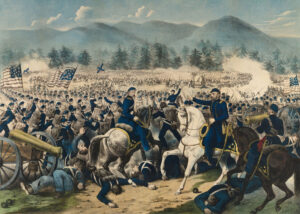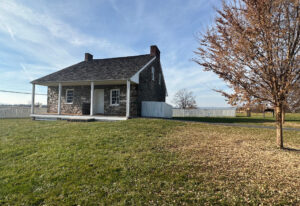With the president in the hot seat, Northern leaders gather to pledge their support—if they could only figure out how to support each other.
By the summer of 1862, Abraham Lincoln’s presidency was in a tailspin.
The Union Army of the Potomac had failed to capture Richmond and had suffered a disastrous defeat in August at the Second Battle of Bull Run. Difficulties with General-in-Chief George B. McClellan also plagued his administration, and several Northern governors with differing views on the war withheld men and supplies. But Governor Andrew Gregg Curtin of Pennsylvania had been a longtime supporter of Lincoln and well understood the dilemmas facing the president and his administration. He saw an opportunity to muster support for the beleaguered chief executive.
Governor David Tod of Ohio and Provisional Governor Francis Pierpont of what would become West Virginia—moderates with whom Curtin held common ground—concluded with Curtin that a meeting of Northern governors who supported the president would be the most effective means to ensure that each state was doing its part to achieve ultimate victory for the United States.
On September 6, 1862, Curtin dispatched a message to Governor John A. Andrew of Massachusetts asking whether “In the present emergency would it not be well if the loyal governors should meet at a point in the border states to take measures for a more active support of the Federal government?” Andrew replied enthusiastically that he believed such a conference was the best course of action.
Six days later, Curtin sent a message to all fellow Northern governors. “We invite a meeting of the governors of the loyal states to be held in Altoona, Pennsylvania on the Twenty-fourth instant,” he wrote. Some agreed right away; some blatantly refused. Governor Edwin D. Morgan of New York, for example, had no desire to take part in any dealings with Lincoln or Curtin and their “abolitionist cause.”
Controversy dogged the War Governors’ Conference almost from the start. Because the meeting was to remain a secret, many suspected the governors planned to overthrow Lincoln and assume command themselves to push an agenda of radical abolitionism. Others feared that the meeting would result in McClellan’s removal. Although the sluggish “Little Napoleon” had failed to achieve many of his military objectives, his fondness for the troops had won him the loyalty of multitudes.
The conjecture prompted Curtin and Andrew to personally trek to the White House to discuss their motives with Lincoln himself. The president whole-heartedly approved, concurring that he needed all the political help he could get.
Lincoln also told Andrew and Curtin about a new document lying in his desk drawer—the Emancipation Proclamation, the text that would “free” slaves being held in those states currently in rebellion. The president said he would issue it if McClellan could defeat Robert E. Lee, moving through Maryland at that point with the Army of Northern Virginia. Lincoln said he was hesitant to deliver the proclamation before the governors’ conference, but Andrew and Curtin insisted it be issued as soon as possible so their own intentions would be clear.
Confidence in McClellan grew when he claimed victory at the Battle of Antietam on September 17. Although Lee’s army managed to avoid destruction and flee back into Virginia, McClellan held the field and gave Lincoln the triumph he had hoped for to release the Emancipation Proclamation. Lincoln issued the document on September 22, the day before the governors’ conference was to begin.
Altoona—the conference site—was an industrial town dominated by the presence of the powerful Pennsylvania Railroad. The transportation hub provided comfortable travel and easy access for the governors, while being a less hectic and more secure locale than Washington or Philadelphia. Not only was Altoona on the mainline of the railroad, it was a central location between the New England states and the Midwest. The meeting took place at the Logan House, a 106-room luxury hotel with modern amenities such as gaslights and hot running water.
Although the meeting was to be kept secret, word eventually leaked to townspeople and travelers passing through—who quickly booked the hotel. General John McClernand was journeying through Altoona on his way to the capital when he decided to stop and witness some of the proceedings.
On the morning of September 24, the governors picked up copies of the Altoona Tribune to read the newly issued Emancipation Proclamation. The proclamation, Governor Andrew assessed, “is a poor document, but a mighty act.”
Before the meeting was called to order, the governors discussed military dilemmas with curious onlookers but would not say why they were in Altoona. A sentry was assigned to the door and the conference began at about 1 p.m.
Eleven state executives and a number of representatives gathered around a large walnut table, now preserved in the collections of the Blair County Historical Society. Curtin welcomed the group, declaring that they were there “to enable the President to secure a more vigorous and successful prosecution” of the war. But the tranquility of the meeting quickly dissipated when Massachusetts’ Governor Andrew took the floor.
Andrew, who despised George McClellan, openly criticized the general for dawdling and failing to destroy Lee’s army at Antietam the week before. He demanded that the first proposition adopted by the conference be the removal of McClellan from command.
Rhode Island’s William Sprague IV, the youngest of the governors present, agreed—calling Antietam “a rebel victory” and claiming that the Confederates had not retreated “because they were defeated, but exhibited great military strategy in doing so.”
“On this point there was some difference of opinion,” Samuel Kirkwood of Iowa later recalled, “but my recollection is that the decided majority were of opinion that the public welfare would be promoted by his retirement from command of the Army of the Potomac.”
While Curtin politely made the point that McClellan may have prevented Lee from invading Pennsylvania, Tod of Ohio was more resolute in his defense of “Little Mac,” expressing “surprise that any person would attempt to remove McClellan” and declaring that the people of Ohio “would rise up en masse and repudiate any such project.” Tensions ran high as debate continued until a recess was called at 8 p.m.
During the recess, Curtin rested on the hotel’s veranda. His vision of a conference uniting the governors was, in fact, doing the opposite. The question of McClellan’s capabilities proved to be a more divisive issue than originally believed. Nevertheless, Curtin re-entered the meeting with a renewed sense of confidence and a plan to reverse the negative atmosphere.
The meeting resumed shortly after 9 p.m. This time Curtin went straight to the point, offering a “preamble and resolution on the war, approving the President’s Emancipation Proclamation” and making “indirect allusions” to address the McClellan issue. Sprague argued that they should mention McClellan directly, but others disagreed. For another three hours, they discussed how best to support the document and its ideals of abolitionism and preservation without being perceived as too radical. Debate ended around 12:30 a.m.
Andrew took notes during the deliberations and spent nearly a half-hour modifying the preamble to a point most could agree upon. All the governors signed on except Maryland’s Augustus W. Bradford, who feared the consequences since he was governor of a state that still permitted slavery. “Gentlemen, I am with you in heart and soul,” he said, “but I am a poor man, and if I sign that address, I may be a ruined one.”
The resolution covered a broad number of issues facing the country. It called for a reserve army of 100,000 men to further help suppress the rebellion and for instituting a draft if necessary. And it pledged undying support for Lincoln and his policies, including the newly issued Emancipation Proclamation.
A telegram including the document’s key points was finally sent to Lincoln. The president quickly invited the governors to meet at the White House to fully discuss their meeting when they were prepared to do so. The conference finally adjourned at 1:30 a.m.
Governor Austin Blair of Michigan arrived later that morning. Although he had missed the proceedings, he read over the resolution and signed it.
The governors arrived at the White House on the afternoon of September 26. John Andrew read the document aloud, stating that “the duty and purpose of the loyal states and people is to restore and perpetuate the authority of this government and the life of the nation…and we pledge without hesitation to the President the most loyal and cordial support in the exercise of the functions of his great office.”
Andrew promised the governors would “continue in the most vigorous exercise of all our lawful powers, contending treason, rebellion, and the public enemies until final victory and unconditional submission” as well as “promote the military education of the people.”
Some of the more agitated governors might have been tempted to bring up the issue of McClellan, but the president delayed them. Eventually, Kirkwood let the president know he wanted the general removed but feared mutiny within the army if it were to happen. Lincoln replied that if McClellan warranted admonishment, he would do it “tomorrow.” The president would give McClellan one more chance, but his patience was wearing thin.
Lincoln welcomed the governors’ declaration of support. The Emancipation Proclamation and the governors’ endorsement of it helped prevent foreign intervention on behalf of the South. The governors pledged to raise additional troops and promote the policies of the administration to further preserve the Union.
The document was sent to other governors who did not attend the conference. Of those, the leaders of Connecticut, Kansas, Minnesota, Oregon and Vermont approved of the decree. The governors of Delaware, Kentucky, Missouri, New Jersey and New York all declined or flatly rejected the resolution; three of those states permitted slavery.
Public reaction was mixed. One Curtin biographer emphatically wrote that “the Altoona Conference was, next to the Proclamation of Emancipation, the most decisive civil event of the war.” The New York Herald called the conference a “treasonable…plot that had been set foot on by the radicals to abolish the Union, the constitution, and Negro slavery together, without regard to legal, moral or social obstacles.” Copperheads called the conference a conspiracy that forced Lincoln to issue the proclamation. Curtin and the others were condemned as “Disloyal Governors of the Loyal States.”
Many of the governors, on the other hand, believed the conference to be among their greatest contributions to the war effort. “The publication of the address made known to the people the vigorous policy recommended by the governors,” wrote Austin Blair. “It had some influence in restoring confidence in the ability of the government to sustain itself, promoted enlistments, infused greater activity into the recruiting service, tended greatly to strengthen the armies, and silence the disloyal.”
Even so, the conference largely faded from the pages of history, partly because of its clandestine nature. No official minutes were kept; only the personal notes of those in attendance—most of which have been lost or intentionally destroyed out of security concerns. The Battle of Antietam and release of the Emancipation Proclamation, which occurred within a week of the conference, also rather overshadowed the meeting and its resolution.
But Sprague argued that “there are unnumbered reasons, as facts, to show that the meeting or its effects, made it possible for the Union armies to win.” Many years later, Curtin wrote, “All that was done at the Altoona Conference had the positive approval of President Lincoln in advance, and he well understood that the sole purpose of the movement was to strengthen his hands and support the bolder policy that all then knew was inevitable.”
Jared Frederick is a native of Altoona, Pa., and is a student at Penn State University. You can visit his Web site at www.historymatters.biz.
Originally published in the September 2009 issue of America’s Civil War. To subscribe, click here.




